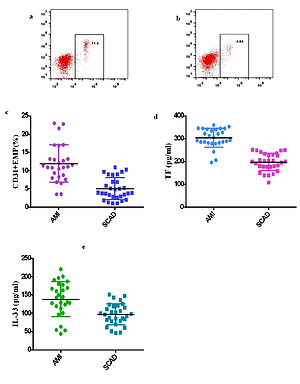Current issue
Archive
Manuscripts accepted
About the Journal
Editorial office
Editorial board
Section Editors
Abstracting and indexing
Subscription
Contact
Ethical standards and procedures
Most read articles
Instructions for authors
Article Processing Charge (APC)
Regulations of paying article processing charge (APC)
CORONARY ARTERY DISEASE / CLINICAL RESEARCH
IL-33/ST2 signaling promotes TF expression by regulating NF-κB activation in coronary artery endothelial microparticles
1
Department of Cardiology, People’s Hospital of Xinjiang Uygur Autonomous Region, China
2
Xinjiang Emergency Center, People’s Hospital of Xinjiang Uygur Autonomous Region, China
Submission date: 2021-04-20
Final revision date: 2021-05-09
Acceptance date: 2021-05-15
Online publication date: 2021-05-22
Corresponding author
Nijiati Muyesai
People’s Hospital of Xinjiang Uygur Autonomous Region, 120 Longquan Street, Urumqi 830001, Xinjiang, China, Tel.: +86-13899955322
People’s Hospital of Xinjiang Uygur Autonomous Region, 120 Longquan Street, Urumqi 830001, Xinjiang, China, Tel.: +86-13899955322
KEYWORDS
TOPICS
ABSTRACT
Introduction:
Interleukin 33 (IL-33) was previously shown to induce angiogenesis and inflammatory activation of endothelial microparticles (EMPs). Tissue factor (TF) plays a central role in hemostasis and thrombosis.
Material and methods:
The study analyzed the coronary blood of level of CD31+EMPs, TF protein and IL-33 protein in acute myocardial infarction (AMI) and stable coronary artery disease (SCAD) patients. Human coronary artery endothelial cells (HCAECs) were treated with IL-33 to obtain EMPs. The TF activity of EMPs was tested by Thermo Fisher by adding the TF antibody. Furthermore, TF and tissue factor pathway inhibitor (TFPI) protein were tested by ELISA. Finally, NF-κB inhibitor dimethyl fumarate (DMF) and soluble extracellular domain of ST2 coupled to the Fc fragment of human IgG1 (sST2) were added to HCAECs which were treated with IL-33, and the TF protein level was also tested by ELISA.
Results:
The AMI patients had higher levels of CD31+EMPs, TF protein and IL-33 protein than the SCAD patients in the coronary artery. In AMI patients (n = 27), the IL-33 protein positively correlated with CD31+EMPs (r = 0.794, p < 0.01). According to the ROC curve analysis, the AUC of CD31+EMPs, TF protein and IL-33 protein were 0.888, 0.962 and 0.778 respectively. In the cell culture, the TF activity and TF protein in EMPs increased gradually with time of intervention by the treatment of IL-33. IL-33 binding to the ST2 receptor promoted TF expression by regulating NF-κB activation in EMPs of HCAECs.
Conclusions:
Activated endothelial cells and EMPs they release simultaneously express TF, which is a risk factor for cardiovascular disease.
Interleukin 33 (IL-33) was previously shown to induce angiogenesis and inflammatory activation of endothelial microparticles (EMPs). Tissue factor (TF) plays a central role in hemostasis and thrombosis.
Material and methods:
The study analyzed the coronary blood of level of CD31+EMPs, TF protein and IL-33 protein in acute myocardial infarction (AMI) and stable coronary artery disease (SCAD) patients. Human coronary artery endothelial cells (HCAECs) were treated with IL-33 to obtain EMPs. The TF activity of EMPs was tested by Thermo Fisher by adding the TF antibody. Furthermore, TF and tissue factor pathway inhibitor (TFPI) protein were tested by ELISA. Finally, NF-κB inhibitor dimethyl fumarate (DMF) and soluble extracellular domain of ST2 coupled to the Fc fragment of human IgG1 (sST2) were added to HCAECs which were treated with IL-33, and the TF protein level was also tested by ELISA.
Results:
The AMI patients had higher levels of CD31+EMPs, TF protein and IL-33 protein than the SCAD patients in the coronary artery. In AMI patients (n = 27), the IL-33 protein positively correlated with CD31+EMPs (r = 0.794, p < 0.01). According to the ROC curve analysis, the AUC of CD31+EMPs, TF protein and IL-33 protein were 0.888, 0.962 and 0.778 respectively. In the cell culture, the TF activity and TF protein in EMPs increased gradually with time of intervention by the treatment of IL-33. IL-33 binding to the ST2 receptor promoted TF expression by regulating NF-κB activation in EMPs of HCAECs.
Conclusions:
Activated endothelial cells and EMPs they release simultaneously express TF, which is a risk factor for cardiovascular disease.
We process personal data collected when visiting the website. The function of obtaining information about users and their behavior is carried out by voluntarily entered information in forms and saving cookies in end devices. Data, including cookies, are used to provide services, improve the user experience and to analyze the traffic in accordance with the Privacy policy. Data are also collected and processed by Google Analytics tool (more).
You can change cookies settings in your browser. Restricted use of cookies in the browser configuration may affect some functionalities of the website.
You can change cookies settings in your browser. Restricted use of cookies in the browser configuration may affect some functionalities of the website.



